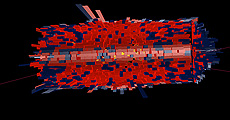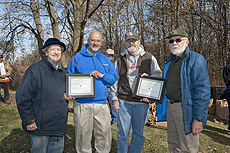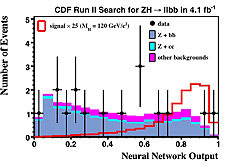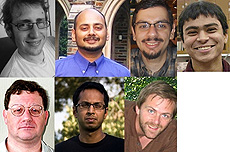|
Thursday, Nov. 4
- Breakfast: apple sticks
- Southwestern chicken tortilla
- Philly-style cheese steak
- *Garlic herb-roasted pork
- *Mardi Gras jambalaya
- *Southwestern turkey wrap
- Assorted sliced pizza
- *Marinated grilled chicken Caesar salads
*Carb restricted alternative
Wilson Hall Cafe Menu
|
|
Thursday, Nov. 4
Dinner
- Mixed greens w/ pecans, goat cheese & dried cranberries
- Lamb chops w/ herb & olive crust
- Garlic mashed potatoes
- Sauteed tri-colored peppers
- Pear tart
Chez Leon Menu
Call x3524 to make your reservation.
|
|
|
Large Hadron Collider pauses protons; looks ahead to lead
 |
View of a central lead-ion collision event in the CMS detector in which jets of particles were produced. The jets can be seen at the top of the image. Credit: CERN |
Batavia, IL, Berkeley, CA and Upton, NY – The Large Hadron Collider’s first record-setting run of high-energy proton collisions ended today, and scientists are now readying the accelerator to meet its next challenge: the world’s highest-energy collisions of lead ions.
“Over the last seven months, the intensity of the LHC’s proton beams has increased 200,000 times, and the scientists from the LHC experiments have quickly converted proton collisions into scientific results,” said Dennis Kovar, Associate Director of Science for High Energy Physics at the U.S. Department of Energy. “This is excellent progress for the brand-new accelerator and detectors, and bodes well for discoveries in the years to come.”
The LHC at the CERN particle physics laboratory in Geneva, Switzerland will spend the next month colliding lead ions – atoms of lead with all of their electrons stripped off during the acceleration process. The teams operating three of the four major LHC experiments – ALICE, ATLAS and CMS – will record and analyze data from these record-setting “heavy-ion” collisions, in which up to 10,000 particles will stream from each high-energy collision. This next phase of the LHC will provide the first full test of the capabilities of the ALICE experiment, which was designed specifically to record heavy-ion collision data. The lead-ion collisions will be used to investigate the quark gluon plasma, a state of matter that physicists believe existed millionths of a second after the Big Bang.
Read more
|
Volunteers recognized for 30 years of prairie harvest
 |
From left: Ruthanne Baird, Fermilab Director Pier Oddone, Fermi Natural Areas Director Rod Walton, and Keith Olson at the Prairie Seed Harvest on Oct. 30. |
For an ecosystem, 30 years can be the blink of an eye. But community members Ruthanne Baird and Keith Olson have seen and helped the prairie change significantly during the 30 years they have volunteered at Fermilab’s Prairie Seed Harvest. Year after year, they keep coming back to improve it.
At the most recent seed harvest, which took place on Saturday, Oct. 30, Director Pier Oddone presented Baird and Olson with certificates and framed photographs of the prairie in recognition of their service to preserve Fermilab’s natural beauty.
“When you’ve volunteered for more than 30 years and haven’t missed one, that’s an extraordinary thing,” Oddone said.
He presented the certificates while 190 hot-dog-eating volunteers took a lunch break from filling brown bags with diverse species of prairie plant seeds. Many volunteers were from children’s groups such as Campfire Scouts and Children of the American Revolution, who have collectively volunteered for as long as Bard and Olson.
“The people I’ve met are just terrific. That’s what keeps it going,” Baird said as she accepted the award.
Baird became involved in prairie restoration because of her sons, one of whom helped clear Schulenberg Prairie as an Eagle Scout project. She remembers when just a few volunteers used to clean the seed in the barn and has watched the harvest effort consistently grow over the years.
Olson recalled his first volunteer visit to the Fermilab prairie. He brought a vanload of students to clean seed in the barn in the mid-1970s.
“By any standard and any place, anyone who can volunteer that long is pretty special,” said Roads and Grounds’ Bob Lootens. “The example they set inspires the rest of us.”
-Sara Reardon
|
How the early universe cleared away the fog
From ScienceNow, Nov. 3, 2010
About 300,000 years after the big bang, the universe was like a smoke-filled chamber from which light could not escape. By the time the universe was a billion years old, the smoke—actually a gas of light-trapping hydrogen—had cleared almost entirely, allowing stars and galaxies to become visible. But exactly what cut through the haze has been one of the big questions in astrophysics. Now, by analyzing images taken by the Hubble Space Telescope, researchers have come close to confirming their best guess: the smoke was cleared away by a blaze of ultraviolet radiation from the earliest galaxies.
About 300,000 years after the big bang, the first atoms formed as protons combined with electrons to make hydrogen. Because hydrogen atoms trap light, the young universe entered its "dark ages." Then about a billion years later, some sort of radiation had ionized the hydrogen, turning it into a transparent broth of electrons and ions over a period of several hundred million years; the period is known as the Epoch of Reionization.
Read more
|
|
|
Improved CDF Higgs search: No event left behind
 |
| The figure shows the neural network output for events with a Z candidate
and two b-tagged jets (for one of the six subchannels in the overall CDF ZH search).
The output for a hypothetical Higgs signal is shown by the red line (magnified by a factor of 25).
|
Tevatron physicists hoping to find evidence of the Higgs boson face an uphill battle. Assuming that the Higgs exists, physicists expect that only one in 100 billion collisions will produce the particle. To discover or exclude the existence of the Higgs, physicists must retain as many of these rare events as possible while rejecting the more plentiful background events that can mimic the particle's signal.
This process requires searching in all of the predicted Higgs production and decay modes. In one such decay mode, a Higgs is produced alongside a Z boson decaying to electrons or muons. Assuming the Higgs decays to two b-quarks, this mode provides a distinct decay signature where physicists can observe all the resulting decay products. CDF physicists recently completed a search in this channel using several new techniques to extract the maximum information from these rare events.
Physicists expect to reconstruct the mass of a Z boson from the pair of electrons or muons in each event, which were drawn from as large a region of the detector as possible. In this channel, CDF physicists also expect to reconstruct the mass of the Higgs using the energy of the two b-quark jets in each event. The energy was fine-tuned using an artificial neural network trained specifically to correct jet energies in this type of event.
Finally, CDF physicists filtered out background-like events using another artificial neural network. This network uses measured properties of the decay particles and the predetermined probability that each event results from Higgs or background.
All told, these improvements resulted in the search being 20 percent more sensitive than a previous search in the same channel - equivalent to more than a year's worth of Tevatron data.
Physicists made the final measurement with 4.1 inverse femtobarns of data. The measurement yielded an upper limit on Higgs boson production in association with a Z boson of 5.9 times the expected rate in the Standard Model.
A paper on this analysis based on the Ph.D. thesis of Shalhout Z. Shalhout has been submitted to Physical Review Letters. CDF physicists are continuing to make even more Higgs events pop out of the many Tevatron collisions they observe.
More information
-- edited by Andy Beretvas
 |
First row from left: Daniel Whiteson, UC Irvine; Ashutosh Kotwal, Duke; Shalhout Shalhout, UC Davis; Ravi Shekhar, Duke. Second row from left: Rob Harr, Wayne State; Bo Jayatilaka, Duke; Ben Kilminster, Fermilab. |
|
|